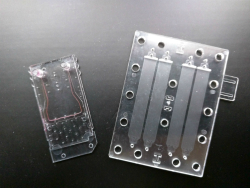Plastic chip detects waterborne viruses
Urban wastewater contains large numbers of human pathogenic viruses, which cannot be completely removed by even the most advanced wastewater treatments. Furthermore, conventional biological water quality indicators are both time consuming and labour intensive, and do not provide adequate information about the presence of pathogenic viruses. These challenges have been addressed by the project AQUAVIR (Portable automated water analyser for viruses). The consortium, comprising 14 partners from 8 European countries, set out to develop a prototype virus sensor system for monitoring rotavirus, norovirus and hepatitis A virus in various types of water meant for human use. 'The virus monitoring system is intended to detect virus particles in a concentrated water sample on the basis of an electrical readout. Measurement data can then be sent to a monitoring station', says Dr Noemi Rozlosnik, the coordinator of AQUAVIR. 'The system consists of a "Water sampling and filtering unit" (WSFU) and a "concentration and measuring system" (CMS), which includes a virus concentration unit (VCU) and a virus detection unit (VDU).' Water samples are collected by the WSFU and passed through a rough filter to remove particulates and then through glass wool. An elution buffer is then employed to recover the viruses from the glass wool and the collected sample stored for further processing. The VCU meanwhile is used to further increase virus concentration in the liquid sample to improve the limit of detection of the system. Targeted viruses are accurately detected with the aid of a single-use inexpensive plastic chip. Within the sensor chip several sets of electrodes are exposed to a liquid sample. The electrodes are functionalised with the specific recognition molecules (aptamers), which have a strong affinity for the pathogens they are detecting. 'The recognition molecule, the aptamer, is a short oligonucleotide sequence (single stranded DNA) with a function similar to antibodies, and the detection of the target pathogens is based on electrical measurement. Therefore, it is possible to detect different analytes at the same time on the different electrodes', Dr Rozlosnik explains. AQUAVIR results include proof-of-concept for the concentration of virus particles from a water sample using a microfluidic chip and the detection of norovirus in raw water, surface water and wastewater. Additional results involve the mass production of disposable all-plastic chips for detection of pathogens. Development of an easy-to-use portable multi-sensor using inexpensive chips will help to reduce the costs of monitoring viral pathogens. It will also enable the standardisation of virus contamination levels in water, as quantitative results can be obtained from the electrical readout to provide a routine virus test. The largest potential market for the AQUAVIR virus detection system is within the water industry. Other end users include environmental inspectorates and water directorates who would benefit from the use of the virus sensor in regular surveillance monitoring as required by the EU Water Framework Directive (WFD). Moreover, end users can establish databases or complement existing ones on the virological state of water bodies or check raw water resources before and after the use of water treatment technologies. This will be of particular interest to the agro and food industries, breweries and dairies.
Keywords
Water quality, pathogenic viruses, AQUAVIR, aptamers, electrical detection







